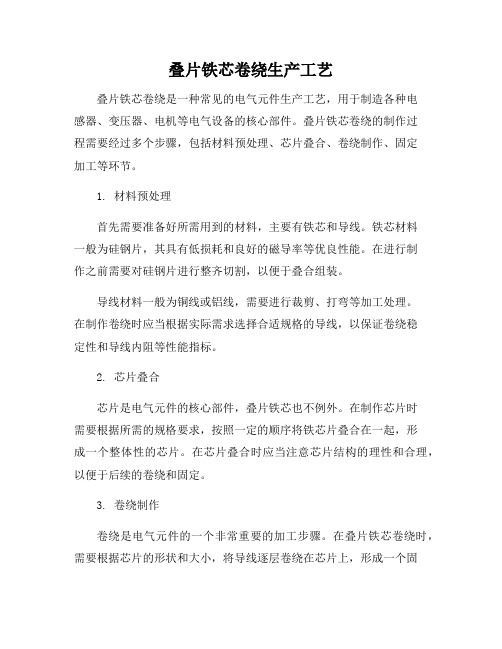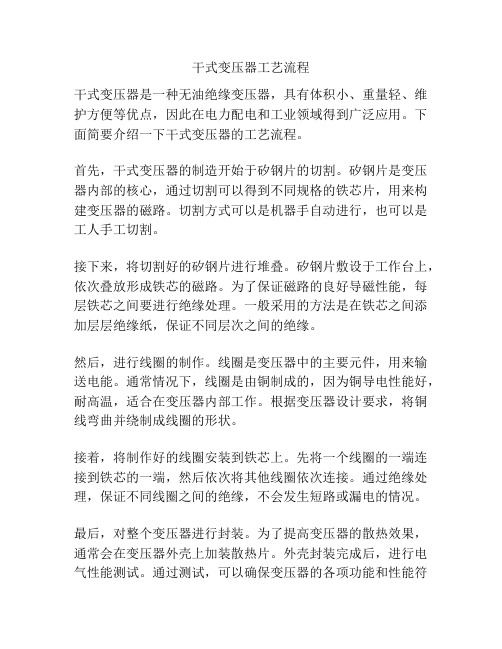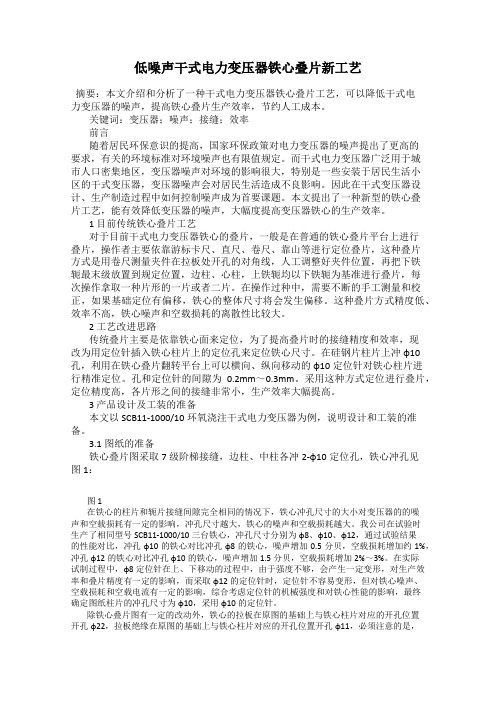干式变压器铁芯叠片流程
变压器铁心叠装工艺

变压器铁心叠装工艺天水长城电工电器制造有限公司铁心叠装工艺1.适用范围1.1本工艺守则适用于电压等级35KV及以下SC系列树脂浇注干式变压器铁心叠装。
1.2本工艺仅在图样中生效。
2.设备及工具2.1叠装平台、起重吊车、铁芯夹具、辅助夹具、卷尺、水平尺、铁锤、胶木板、扳手、钢丝钳、漆刷、定位栓等。
3.准备工作3.1看清图纸及质量标准。
3.2按图纸规定的尺寸进行叠片(包括长、宽、厚)3.3根据图纸检查将要进行叠片的规格是否符合图纸尺寸,前一工序交来的零部件、如夹件、夹件绝缘、护板、硅钢片等是否有合格证。
3.4将各号片分别放在便于工作的地方。
3.5将叠片架放好,把周围的杂物清理干净。
4.工艺过程4.1现在平台上放置两条槽钢,然后垂直放上有绝缘垫块的夹件,使夹件位置符合图纸要求,两夹件之间放等高的辅助夹件(一般辅助夹件间隔200~300mm),用水平尺和垫块调整夹件与辅助夹件成一个水平面,防止铁心柱下垂,造成铁芯柱歪斜,有拉板的,放上拉板和拉板绝缘,无拉板的放上铁柱封面纸板。
4.2按图纸的铁芯叠积图,两片一叠,三级接缝叠积,铁心叠片次序严格按照a、b、c次序进行。
4.3对接缝,两人在同一铁心柱(或铁轭)的两侧,由上往下逐级叠放。
4.4在叠第一层片的时候,角度应吻合,无离缝,并测量对角线S1、S2,S1、S2对角线应相等。
4.5根据铁芯大小,可用胶木块一级一靠打,也可15~20mm厚打齐一次,使接缝达到最小,禁止用锤直接敲打硅钢片,叠到30~40mm 时,把定位栓插入铁芯。
4.6每叠完一级,应进行一次修整,铁心柱片应与铁轭垂直,无搭头,测量铁芯厚度和对角线长度,注意防止每级片在宽度方向移动,叠至规定厚度后,开始下一级叠装。
4.7每叠到15~30mm时,用手轻摇或转动定位栓,让定位栓在铁芯孔里插取畅通。
4.8逐级叠放,逐级检查。
4.9叠完主级后,除全面检查一次接缝、垂直、搭头外,还要做如下检查;(1)检查上下铁轭两个端面,至少检查两点;(2)检查是否有漏片或错叠,如发现,应予纠正。
干式变压器制造工艺流程

干式变压器制造工艺流程
干式变压器制造主要由原材料检验入库、变压器的组装、线圈的制造、总装配、温控系统的制作调试几大部分组成。
这几部分在变压器制造过程中几乎是同步进行的。
各部件加工完成后进行总装配。
一、原材料、配件、外购件入库
包括金属零件、高低压铜导线(铜箔)、硅钢片绝缘零件、金属结构件、黑色金属、配件、附件的检验入库。
二、变压器部件制作
1、铁芯制造,其中包括硅钢片剪切、硅钢片的预叠、铁芯装配、铁芯绑扎及入炉干燥、铁芯试验。
2、线圈的制造
①首先是绝缘件制作与准备。
②通过分段圆筒式高压线圈绕制、箔式线圈绕制、环氧浇注模具表面处理、环氧树脂浇注、环氧树脂浇注线圈烘焙固化、浇注式线圈脱模、线圈表面处理等一系列工艺流程的加工后线圈转装配工序待进行器身组装。
3、器身装配,其中包括绝缘件装配,器身入炉干燥(绝缘电阻测量)、线圈的套装、插板及夹铁、引线装配、器身半成品做试验。
三、总装配,
1、器身的整理与紧固、铁芯对地绝缘电阻的测量、检查器身清洁度及各零部件的紧固程度,分接线及引线绝缘距离。
2、温控系统,风机的制作、安装、调试。
3、送检,作变压器出厂项目试验,试验合格后按包装、运输及贮存工艺,办理入库手续。
电力变压器铁芯叠片操作要点

叠片操作要点1、熟悉图纸和质量要求,准备好叠片过程中所需要材料、零配件、工具及工装;2、把尺寸超差和不合格的废片调出来不用;3、用布清洁上下夹板,并放好夹件及绝缘和封片,辅助槽钢在125KV A以及下时铺一根,125KV A以上时应铺两根,并在辅助槽钢和铁芯封片交叉处分别放置扁钢一块,630KV A以上容量的辅助槽钢不应挡住夹件两头的拉螺杆孔,注意用水平尺检查上下夹件及辅助槽钢上端面应在同一平面上。
4、用卷尺测量上下夹件平行度和对角线应控制在1mm以内。
5、叠装铁芯时一般使用两片一叠的方式,并按照“中、左、右”的顺序放置中柱片,每三层为一个循环。
每叠完一级或厚度超过15mm时,应用铜质或用胶木打平垫块敲齐一次铁芯端面,缩小接缝,消除搭头和端面的参差不齐,进行整形和自检。
6、注意叠片时片的厚度,遇有厚薄不均的铁芯片时,应均匀分开放在没级的芯柱上边,以避免使芯柱的叠厚不一致。
必要时对较薄的一边采用三片一叠。
每级厚度用游柱卡尺或钢直尺在压紧状态测量时应符合图纸规定的厚度,注意留有一定的裕度,主级厚应有一个正偏差。
7、应选择较好的片作为每级的上下封面片,应特别注意上轭必须全部用较好的片,每层带折痕的片或无涂层的片必须要用较好的片隔开。
8、叠至最后三级时,将铁芯临时加紧,用卡钳测量总厚度。
根据误差调整最后三级的叠级厚度,使总厚度控制在+2mm以内,并进行全面的检查和整形。
9、放好另一部分夹件及绝缘、垫脚等,注意方向不要搞错,拧紧螺杆螺帽时注意应将螺杆两端出头和调整一次,拉螺杆下端长度不得超过垫脚。
纸管端口应光滑,长度一致,并不得顶夹件。
10、垫脚垫块应用烘干杂木制作,不合适时应予修整,以使其与铁芯下轭端面靠紧。
11、夹装铁芯时应先紧夹螺杆,后拧紧拉螺杆;先中间,后两边。
12、试验完毕,需绑扎的铁芯柱应用无纬带或紧缩带对芯柱进行绑扎,且应均匀一致,不得有悬浮头。
13、用压缩空气吹净铁芯本体,然后再芯柱和下轭端面刷聚氨酯清漆一层,注意上轭及芯柱靠近上轭部分不能刷漆,并注意不要将漆滴在夹件和铁芯片上。
叠片铁芯卷绕生产工艺

叠片铁芯卷绕生产工艺叠片铁芯卷绕是一种常见的电气元件生产工艺,用于制造各种电感器、变压器、电机等电气设备的核心部件。
叠片铁芯卷绕的制作过程需要经过多个步骤,包括材料预处理、芯片叠合、卷绕制作、固定加工等环节。
1. 材料预处理首先需要准备好所需用到的材料,主要有铁芯和导线。
铁芯材料一般为硅钢片,其具有低损耗和良好的磁导率等优良性能。
在进行制作之前需要对硅钢片进行整齐切割,以便于叠合组装。
导线材料一般为铜线或铝线,需要进行裁剪、打弯等加工处理。
在制作卷绕时应当根据实际需求选择合适规格的导线,以保证卷绕稳定性和导线内阻等性能指标。
2. 芯片叠合芯片是电气元件的核心部件,叠片铁芯也不例外。
在制作芯片时需要根据所需的规格要求,按照一定的顺序将铁芯片叠合在一起,形成一个整体性的芯片。
在芯片叠合时应当注意芯片结构的理性和合理,以便于后续的卷绕和固定。
3. 卷绕制作卷绕是电气元件的一个非常重要的加工步骤。
在叠片铁芯卷绕时,需要根据芯片的形状和大小,将导线逐层卷绕在芯片上,形成一个固定的电感器、变压器或电机等元件。
在卷绕制作时应当注意导线的布置和整齐性,以保证卷绕稳定性和电气性能。
4. 固定加工卷绕完成后,需要对其进行固定加工,以便于保证电气元件的稳定性和机械强度。
固定加工的方式一般为焊接、黏合、压合等,根据实际情况选择合适的加固方式。
在焊接和压合等加工过程中应当注意不要过度加工,以免损害电气元件的结构和性能。
叠片铁芯卷绕生产工艺需要经过多个环节,每个环节都需要严格执行,以确保电气元件的质量和性能。
在生产过程中应当对每个环节进行分析和改进,以便于提高工艺水平和创新产品性能。
铁心叠装工艺

变压器有限公司共8 页第1 页1.适用范围1.1 本工艺适用于容量20000kVA及以下,且为框式结构,直接缝、斜接缝、全斜接缝或半斜接缝片形的油浸式变压器的铁芯叠装。
1.2 结构类似的干式变压器,除绝缘材料按干式变压器要求的配置使用外,其余部分可以参照本工艺相关条款实施。
1.3 本工艺不适用于非晶合金铁芯和卷铁芯的叠装、加工。
2.使用的设备、工装及工、量器具与易耗品2.1 主要设备铁心叠装台、行车或其他相应的起重设备(包括尼龙起吊绳或钢丝绳)。
2.2 辅助设备和工装铁心翻身架、空气压缩机(或高压气流吹风机)、各种厚度和各种长度的垫或夹紧用槽钢、垫块、垫木。
2.3工具规格齐全的扳手和套筒、螺丝刀、2磅黄铜质榔头(或小于1.5磅铁榔头)、漆刷、钢丝刷、插片专用刀、硬质木(环氧)垫块。
2.4 量具2m钢卷尺、1000㎜钢直尺、150㎜钢直尺、0~150㎜带深度测量游标尺、500V兆欧(摇)表。
2.4 常用易耗品铁砂皮(纸)、铁心专用粘结剂(适用于油浸式变压器)、铁心专用树脂漆(适用于干式变压器)、漆刷、碱性无纬带、斜纹纱(布)带,等等。
3.工艺准备3.1对照工作任务书,熟悉全部相关的产品加工图和技术、工艺文件,明确该铁心的主要参数:总叠厚、主级叠厚以及绝缘要求。
3.2将装配场地打扫干净,清除与装配无关的物品和其他障碍,并根据铁心的高度和宽度准备好叠装台和铁心翻身架。
3.3检查并确认需装配的铁芯夹件已经检验合格后,将其吊到叠装台架边上放稳当,。
3.4检查并确认需装配的绝缘件已经检验合格且无保管、运输不妥造成的损伤后,同样在叠装台架边上妥善放置。
3.5原则上,铁心总宽度在1000㎜以下的小铁心,可以安排2人对叠;铁心总宽度超过1000㎜的,一般要安排4人相对作业;如果是较大或超大型铁心,则应安排更多的人员帮助传递硅钢片。
3.6检查并确认需叠装的硅钢片已经检验合格后,如果由两人对叠的,则将需要叠装的硅钢片各分一半,在叠装台两端按序放好;如果由四人对叠的,则将需叠装的轭片各分一半,在叠装台两端有序放好、将需叠装的柱片,各分一半,在叠装台两侧按序放好。
变压器铁芯叠片方法

变压器铁芯叠片方法简介:负载曲线的平均负载系数越高,为达到损耗电能越小,要选用损耗比越小的变压器;负载曲线的平均负载系数越低,为达到损耗电能越小,要选用损耗比越大的变压器。
将负载曲线的平均负载系数乘以一个大于1的倍数,通常可取1-1.3,作为获得最佳效率的负载系数,然后按βb=(1/R)1/2计算变压器应具备的损耗比。
关键字:变压器1、变压器损耗计算公式(1)有功损耗:ΔP=P0+KTβ2PK-------(1)(2)无功损耗:ΔQ=Q0+KTβ2QK-------(2)(3)综合功率损耗:ΔPZ=ΔP+KQΔQ----(3)Q0≈I0%SN,QK≈UK%SN式中:Q0——空载无功损耗(kvar)P0——空载损耗(kW)PK——额定负载损耗(kW)SN——变压器额定容量(kVA)I0%——变压器空载电流百分比。
UK%——短路电压百分比β——平均负载系数KT——负载波动损耗系数QK——额定负载漏磁功率(kvar)KQ——无功经济当量(kW/kvar)上式计算时各参数的选择条件:(2)对城市电网和工业企业电网的6kV~10kV降压变压器取系统最小负荷时,其无功当量KQ=0.1kW/kvar;(3)变压器平均负载系数,对于农用变压器可取β=20%;对于工业企业,实行三班制,可取β=75%;(4)变压器运行小时数T=8760h,最大负载损耗小时数:t=5500h;(5)变压器空载损耗P0、额定负载损耗PK、I0%、UK%,见产品资料所示。
2、变压器损耗的特征P0——空载损耗,主要是铁损,包括磁滞损耗和涡流损耗;磁滞损耗与频率成正比;与最大磁通密度的磁滞系数的次方成正比。
涡流损耗与频率、最大磁通密度、矽钢片的厚度三者的积成正比。
PC——负载损耗,主要是负载电流通过绕组时在电阻上的损耗,一般称铜损。
其大小随负载电流而变化,与负载电流的平方成正比;(并用标准线圈温度换算值来表示)。
负载损耗还受变压器温度的影响,同时负载电流引起的漏磁通会在绕组内产生涡流损耗,并在绕组外的金属部分产生杂散损耗。
干式变压器铁芯叠片流程

干式变压器铁芯叠片流程英文回答:Dry-type transformer core laminations stacking process.The core of a dry-type transformer is made up of laminations of electrical steel. These laminations are stacked together to form the core, and the magnetic field created by the windings of the transformer flows through the core. The laminations are insulated from each other to minimize eddy current losses.The stacking process of the core laminations iscritical to the performance of the transformer. If the laminations are not stacked properly, it can lead to increased losses and reduced efficiency. The laminations should be stacked in a way that minimizes the air gaps between them. The laminations should also be stacked in a way that ensures that the magnetic field is evenly distributed throughout the core.There are a number of different methods that can beused to stack the core laminations. One common method is to use a stacking fixture. A stacking fixture is a device that holds the laminations in place while they are being stacked. The stacking fixture ensures that the laminations are stacked in the correct orientation and that the air gaps between them are minimized.Another method that can be used to stack the core laminations is to use a hand-held stacking tool. A hand-held stacking tool is a device that is used to hold the laminations in place while they are being stacked. Thehand-held stacking tool does not provide the same level of precision as a stacking fixture, but it can be used tostack laminations in a variety of different shapes and sizes.Once the core laminations have been stacked, they are secured in place using a variety of methods. One common method is to use a banding press. A banding press is a device that applies pressure to the core laminations tohold them in place. The banding press can be used to apply a variety of different types of banding material, such as steel banding or fiberglass banding.Another method that can be used to secure the core laminations in place is to use a welding process. A welding process is used to fuse the core laminations together. The welding process can be used to create a strong bond between the core laminations, but it can also damage the core laminations if it is not done properly.The stacking process of the core laminations is a critical part of the manufacturing process of a dry-type transformer. If the laminations are not stacked properly, it can lead to increased losses and reduced efficiency. The stacking process should be carried out by a trained technician using the proper tools and equipment.中文回答:干式变压器铁芯叠片流程。
干变铁心叠装工艺

4.4测量上,下夹件的尺寸,使其符合图样的要求。
4.5对准上,下夹件的中心线,放上绝缘件。对于上轭冲孔的铁心,则应该将与铁轭及心柱孔经相对应的导杆放入对应的孔中。
4.6首先放好第一级的首片,校正其角度,必需正确且接缝最小。要求铁心内框对角尺寸偏差小于1mm
螺纹直径(mm)
M6
M8
M10
M12
M16
M20
M24
扭矩(N.m)
10
20
40
75
140
5.4铁心起立
5.4.1清理装配台周围的障碍物。
5.4.2用吹风机吹干净铁心表面。
5.4.3挂好吊钩,用行车起立铁心将铁心吊离叠装台,平稳地放到地面山。
5.4.3对边柱、中柱涂漆,上轭涂漆待到器身装配前进行。漆膜干透后按图纸要求在心柱上绑扎无维带。
4.11下半台迭好后,要进行一次全面校对和整理。不得有搭头、漏片、错片、卷边等缺陷。
4.12叠到最后二到三级前,用铁心夹件夹紧心柱,用卡钳测量叠积厚度,根据图纸总叠厚要求调整最后几级的叠厚。
4.13叠完铁心片,要进行一次全面校对和整理。
5.铁心夹装
5.1对于上轭冲孔的铁心,应将铁轭螺栓一端套上绝缘套管,铁垫圈,保险华司。拧上螺栓,穿入铁轭孔内,再将另一端套上绝缘套管,螺母。用套筒预拧紧螺栓。按图样要求装上接地片。检查铁心四角的垂直度符合要求后。用套筒、扭矩扳手再次拧紧铁轭螺丝,使铁心厚度符合图样要求。按图样装上垫脚,拉紧螺栓,吊角铁和其他铁心另件。对下铁轭涂漆。
3.2按级次将铁心各级硅钢片堆放在迭装四周适当易取处。
3.3.熟悉图样明确规格及要求将所需的夹件,垫脚、绝缘件、螺栓、螺母、垫圈、绝缘垫圈……等,并拿到工作地。
干式变压器工艺流程

干式变压器工艺流程
干式变压器是一种无油绝缘变压器,具有体积小、重量轻、维护方便等优点,因此在电力配电和工业领域得到广泛应用。
下面简要介绍一下干式变压器的工艺流程。
首先,干式变压器的制造开始于矽钢片的切割。
矽钢片是变压器内部的核心,通过切割可以得到不同规格的铁芯片,用来构建变压器的磁路。
切割方式可以是机器手自动进行,也可以是工人手工切割。
接下来,将切割好的矽钢片进行堆叠。
矽钢片敷设于工作台上,依次叠放形成铁芯的磁路。
为了保证磁路的良好导磁性能,每层铁芯之间要进行绝缘处理。
一般采用的方法是在铁芯之间添加层层绝缘纸,保证不同层次之间的绝缘。
然后,进行线圈的制作。
线圈是变压器中的主要元件,用来输送电能。
通常情况下,线圈是由铜制成的,因为铜导电性能好,耐高温,适合在变压器内部工作。
根据变压器设计要求,将铜线弯曲并绕制成线圈的形状。
接着,将制作好的线圈安装到铁芯上。
先将一个线圈的一端连接到铁芯的一端,然后依次将其他线圈依次连接。
通过绝缘处理,保证不同线圈之间的绝缘,不会发生短路或漏电的情况。
最后,对整个变压器进行封装。
为了提高变压器的散热效果,通常会在变压器外壳上加装散热片。
外壳封装完成后,进行电气性能测试。
通过测试,可以确保变压器的各项功能和性能符
合设计要求。
以上就是干式变压器的工艺流程。
除了以上步骤外,还需要进行严格的质量控制,保证每个工艺步骤的准确性和稳定性。
同时,还需要进行产品质量检验,确保生产出来的干式变压器质量可靠,能够保证安全和长期稳定的运行。
铁心叠装工艺

铁心叠装工艺苏州昊海变压器有限公司铁心叠装0HH.910-6401共8页第 1页1.适用范围1.1 本工艺适用于容量20000kVA及以下,且为框式结构,直接缝、斜接缝、全斜接缝或半斜接缝片形的油浸式变压器的铁芯叠装。
1.2 结构类似的干式变压器,除绝缘材料按干式变压器要求的配置使用外,其余部分可以参照本工艺相关条款实施。
1.3 本工艺不适用于非晶合金铁芯和卷铁芯的叠装、加工。
2.使用的设备、工装及工、量器具与易耗品2.1 主要设备铁心叠装台、行车或其他相应的起重设备(包括尼龙起吊绳或钢丝绳)。
2.2 辅助设备和工装铁心翻身架、空气压缩机(或高压气流吹风机)、各种厚度和各种长度的垫或夹紧用槽钢、垫块、垫木。
2.3工具规格齐全的扳手和套筒、螺丝刀、2磅黄铜质榔头(或小于1.5磅铁榔头)、漆刷、钢丝刷、插片专用刀、硬质木(环氧)垫块。
2.4 量具2m钢卷尺、1000㎜钢直尺、150㎜钢直尺、0~150㎜带深度测量游标尺、500V兆欧(摇)表。
2.4 常用易耗品铁砂皮(纸)、铁心专用粘结剂(适用于油浸式变压器)、铁心专用树脂漆(适用于干式变压器)、漆刷、碱性无纬带、斜纹纱(布)带,等等。
3.工艺准备3.1对照工作任务书,熟悉全部相关的产品加工图和技术、工艺文件,明确该铁心的主要参数:总叠厚、主级叠厚以及绝缘要求。
3.2将装配场地打扫干净,清除与装配无关的物品和其他障碍,并根据铁心的高度和宽度准备好叠装台和铁心翻身架。
3.3检查并确认需装配的铁芯夹件已经检验合格后,将其吊到叠装台架边上放稳当,。
3.4检查并确认需装配的绝缘件已经检验合格且无保管、运输不妥造成的损伤后,同样在叠装台架边上妥善放置。
3.5原则上,铁心总宽度在1000㎜以下的小铁心,可以安排2人对叠;铁心总宽度超过1000㎜的,一般要安排4人相对作业;如果是较大或超大型铁心,则应安排更多的人员帮助传递硅钢片。
3.6检查并确认需叠装的硅钢片已经检验合格后,如果由两人对叠的,则将需要叠装的硅钢片各分一半,在叠装台两端按序放好;如果由四人对叠的,则将需叠装的轭片各分一半,在叠装台两端有序放好、将需叠装的柱片,各分一半,在叠装台两侧按序放好。
干式变压器生产工艺

干式变压器生产工艺
干式变压器生产工艺是指在生产过程中将变压器油箱替换为干式绝缘材料的生产方法。
干式变压器生产工艺有以下几个关键步骤:
1. 确定设计参数:根据用户需求确定变压器的额定功率、输入和输出电压、阻抗等设计参数。
2. 铁芯制造:首先需要制造变压器的铁芯。
这一步骤包括剪切硅钢片、按一定规律叠压、焊接固定等工艺。
3. 绕线:将铜线或铝线依照设计要求绕制在铁芯上。
绕线时需要注意导线的截面积、匝数等,保证变压器的性能和负载能力。
4. 绝缘材料处理:绝缘材料可以采用多种干式绝缘材料,如环氧树脂、玻璃纤维布等。
在绝缘材料处理过程中,需要对绝缘材料进行处理和烘干,以确保电气绝缘性能。
5. 组装:将铁芯和绕线部分进行组装,包括绑扎固定、绝缘处理、连接螺栓等步骤。
同时,在组装过程中需要做好各种连接和引线的处理。
6. 测试和调试:组装完成后,需要进行测试和调试,包括电气性能测试、绝缘性能测试、负载能力测试等,以确保变压器的质量和性能达到设计要求。
7. 包装和出厂:经过测试和调试后,将变压器进行包装,包括采用木箱或胶合板箱进行保护,同时进行标签贴附和随机附件的准备。
然后安排出厂。
干式变压器相对于油浸式变压器具有体积小、维护方便、环保等优点,并且适用于室内和室外环境。
生产工艺的精细化和标准化可以提高变压器的生产效率和质量。
低噪声干式电力变压器铁心叠片新工艺

低噪声干式电力变压器铁心叠片新工艺摘要:本文介绍和分析了一种干式电力变压器铁心叠片工艺,可以降低干式电力变压器的噪声,提高铁心叠片生产效率,节约人工成本。
关键词:变压器;噪声;接缝;效率前言随着居民环保意识的提高,国家环保政策对电力变压器的噪声提出了更高的要求,有关的环境标准对环境噪声也有限值规定。
而干式电力变压器广泛用于城市人口密集地区,变压器噪声对环境的影响很大,特别是一些安装于居民生活小区的干式变压器,变压器噪声会对居民生活造成不良影响。
因此在干式变压器设计、生产制造过程中如何控制噪声成为首要课题。
本文提出了一种新型的铁心叠片工艺,能有效降低变压器的噪声,大幅度提高变压器铁心的生产效率。
1 目前传统铁心叠片工艺对于目前干式电力变压器铁心的叠片,一般是在普通的铁心叠片平台上进行叠片,操作者主要依靠游标卡尺、直尺、卷尺、靠山等进行定位叠片,这种叠片方式是用卷尺测量夹件在拉板处开孔的对角线,人工调整好夹件位置,再把下铁轭最末级放置到规定位置,边柱、心柱,上铁轭均以下铁轭为基准进行叠片,每次操作拿取一种片形的一片或者二片。
在操作过种中,需要不断的手工测量和校正,如果基础定位有偏移,铁心的整体尺寸将会发生偏移。
这种叠片方式精度低、效率不高,铁心噪声和空载损耗的离散性比较大。
2 工艺改进思路传统叠片主要是依靠铁心面来定位,为了提高叠片时的接缝精度和效率,现改为用定位针插入铁心柱片上的定位孔来定位铁心尺寸。
在硅钢片柱片上冲φ10孔,利用在铁心叠片翻转平台上可以横向、纵向移动的φ10定位针对铁心柱片进行精准定位。
孔和定位针的间隙为0.2mm~0.3mm。
采用这种方式定位进行叠片,定位精度高,各片形之间的接缝非常小,生产效率大幅提高。
3 产品设计及工装的准备本文以SCB11-1000/10环氧浇注干式电力变压器为例,说明设计和工装的准备。
3.1图纸的准备铁心叠片图采取7级阶梯接缝,边柱、中柱各冲2-φ10定位孔,铁心冲孔见图1:图1在铁心的柱片和轭片接缝间隙完全相同的情况下,铁心冲孔尺寸的大小对变压器的的噪声和空载损耗有一定的影响,冲孔尺寸越大,铁心的噪声和空载损耗越大。
- 1、下载文档前请自行甄别文档内容的完整性,平台不提供额外的编辑、内容补充、找答案等附加服务。
- 2、"仅部分预览"的文档,不可在线预览部分如存在完整性等问题,可反馈申请退款(可完整预览的文档不适用该条件!)。
- 3、如文档侵犯您的权益,请联系客服反馈,我们会尽快为您处理(人工客服工作时间:9:00-18:30)。
干式变压器铁芯叠片流程
The process of stacking laminations for dry-type transformer cores is a crucial aspect of transformer manufacturing. 在干式变压器生产过程中,铁芯叠片的流程是非常关键的。
Firstly, the selection of high-quality silicon steel material is essential for the performance and reliability of the transformer. 首先,选择优质的硅钢材料对于变压器的性能和可靠性至关重要。
Each lamination has to be precisely cut, ensuring the accurate dimensions and minimal air gaps between the laminations. 每个叠片都必须精确切割,确保尺寸准确,叠片之间的空气间隙尽量减少。
The stacking process requires skilled labor and attention to detail to ensure the proper alignment and tight binding of the laminations. 叠片的堆叠过程需要熟练的劳动力和对细节的关注,以确保叠片的正确对齐和紧密绑定。
Furthermore, the insulation between laminations is critical to prevent the occurrence of short circuits and ensure the safety and reliability
of the transformer. 此外,叠片之间的绝缘对于防止短路的发生以及确保变压器的安全性和可靠性至关重要。
The final step involves the pressing and bonding of the laminations using high pressure and temperature, creating a solid core for the transformer. 最后的步骤涉及使用高压和高温对叠片进行压制和粘接,为变压器创建一个坚固的铁芯。
In conclusion, the process of stacking laminations for dry-type transformer cores is a critical and intricate process that requires precision, skill, and attention to detail. 总之,干式变压器铁芯叠片的流程是一个关键且复杂的过程,需要精密度、技能和对细节的关注。
